Climate Change Perceptions, Impacts and Adaptation Strategies: Insights of Fishers in Zambezi River Basin, Zimbabwe
Abstract
:1. Introduction
2. Materials and Methods
2.1. Study Area
2.2. Data Collection
2.3. Data Analysis
2.4. Ethics Statement
3. Results
3.1. Socio-Economic Profile of Respondents
3.2. Fishers’ Perceptions of Changes in Climate Trends and Extreme Weather Events
When it comes to the issue of temperature and rainfall, everything has changed in the past 10 years. The weather was not as bad as it is now. The temperatures are very high throughout the day, and they are few cold days even during the winter season which is different from what we used to experience in the past …(Male, Binga District)
We have already started experiencing hell on earth, in the past few years, from around August to March we are experiencing extreme hot days. Now I must wake up very early in the morning to cast my fishing nets because by eight in the morning it will be hot already …(Male, Binga District)
The temperature has drastically increased in the past 10 years, the summer season has just become too hot, and I am starting to worry about how it is going to be in the next five to ten years from now …(Male, Kariba)
Some days are just becoming too hot for me. If I remember well in the past few years, we were not experiencing hot days as we are experiencing today …(Female, Kariba)
The way it is hot these days we also expect good rains. We used to know that if we have two or three consecutive hot days then it rains but nowadays it can be hot for several days or weeks without a single drop of rain …(Female, Kariba District)
We used to receive considerable amounts of rainfall usually from late October to March but now September and October are usually dry, and we receive little rainfall maybe towards the end of November. Generally, the amount of rainfall is decreasing that’s why we are experiencing a lot of drought seasons(Male, Kariba District)
This area is in the low veld region, and it is generally characterized by low rainfall, but in recent years our area is becoming drier and drier, rainy days have decreased and when it rains the rainfall is not enough to fill up the lake or sustain our crops …(Female, Binga)
The rainfall patterns in this area are becoming more and more unpredictable as we can have long periods of little rainfall causing serious drought situations, and then sometimes we get rainfall of high intensity we usually cause flooding. However, from my personal experience, the area is becoming dry, there is a noticeable decrease in the amount of rainfall received …(Male, Binga)
The water level is always fluctuating with the low water level being very common during the winter season and the level increasing during the rainy season. In recent years, the water level is no longer reaching the higher levels it used to reach in the previous years which might be associated with low rainfall and high evaporation due to increasing temperatures …(Key Informant, Kariba)
In the past few years, the water level is not rising as it used to during most rainy seasons. During the rainy season, the water level used to rise and cover all those small shrubs close to the banks of the lake …(Male, Binga)
3.3. Empirical Evidence of Climate Variability and Trends
3.4. Observed Weather Changes and Their Impacts on Fisheries
I have been fishing in Lake Kariba for more than 30 years now and over time I have noticed that the amount of rainfall we used to receive has declined to cause the lake water level to decline and small water bodies close to our community are drying up. Our prescribed fishing grounds are shrinking due to disappearing surface water resulting in reduced fish catches for us. I used to catch lots of fish in a day and now I have to fish for three or four days to get the same amount I used to get in a day …(Key informant, Kariba)
I am a full-time gill net fisher and climate change, particularly changes in rainfall patterns have affected my fishing profits. Fish come with rains, but in the past years, the rainfall is too little to increase fish availability. During the rainy season, my fish catches used to be amplified but that is no longer the case these days …(Male, Kariba)
The rain has become more unpredictable, and the rainy season is now shorter which is affecting our overall food security situation. Fish is our main source of animal protein and now we are catching less of it if we eat most of the catch, we won’t have a surplus to sell. Droughts are affecting our crops as well; we are not harvesting enough crops to sustain us for the whole year …(Female, Binga)
3.5. Adaptation Strategies of Fishers in Response to Changing Climate
4. Discussion
4.1. Fishers’ Perceptions of Climate Change and Variability
4.2. Perceived Impacts of Climate Change and Extreme Weather Events on Fisheries
4.3. Adaptation Strategies of Fishers in Response to Changing Climate
4.4. Limitations of the Study
5. Conclusions
Author Contributions
Funding
Institutional Review Board Statement
Informed Consent Statement
Data Availability Statement
Acknowledgments
Conflicts of Interest
References
- Intergovernmental Panel on Climate Change (IPCC). Climate Change 2007: Impacts, Adaptations, and Vulnerability; Contribution of Working Group Fourth Assessment Report of the, IPCC; Parry, M., Canziani, O., Palutikof, J., van der Linden, P., Hanson, C., Eds.; Cambridge University Press: Cambridge, UK, 2007. [Google Scholar]
- Niang, I.; Ruppel, O.C.; Abdrabo, M.A.; Essel, A.; Lennard, C.; Padgham, J.; Urquhart, P. Climate Change 2014: Impacts, Adaptation, and Vulnerability. Part B: Regional Aspects; Contribution of Working Group II to the Fifth Assessment Report of the Intergovernmental Panel on Climate Change; Barros, V.R., Field, C.B., Dokken, D.J., Mastrandrea, M.D., Mach, K.J., Bilir, T.E., Chatterjee, M., Ebi, K.L., Estrada, Y.O., Genova, R.C., et al., Eds.; Cambridge University Press: Cambridge, UK; New York, NY, USA, 2014; pp. 1199–1265. [Google Scholar]
- Nangombe, S.; Zhou, T.; Zhang, W.; Wu, B.; Hu, S.; Zou, L.; Li, D. Record-breaking climate extremes in Africa under stabilized 1.5 C and 2 C global warming scenarios. Nat. Clim. Change 2018, 8, 375–380. [Google Scholar] [CrossRef]
- Gizaw, M.S.; Gan, T.Y. Impact of climate change and El Niño episodes on droughts in sub-Saharan Africa. Clim. Dyn. 2017, 49, 665–682. [Google Scholar] [CrossRef]
- Muringai, R.T.; Mafongoya, P.L.; Lottering, R. Climate change and variability impacts on sub-Saharan African fisheries: A Review. Rev. Fish. Sci. Aquac. 2021, 29, 706–720. [Google Scholar] [CrossRef]
- Mohammed, E.Y.; Uraguchi, Z.B. Impacts of climate change on fisheries: Implications for food security in Sub-Saharan Africa. In Global Food Security; Nova Science Publishers, Inc.: Hauppauge, NY, USA, 2013; pp. 114–135. [Google Scholar]
- Gownaris, N.J.; Rountos, K.J.; Kaufman, L.; Kolding, J.; Lwiza, K.M.; Pikitch, E.K. Water level fluctuations and the ecosystem functioning of lakes. J. Great Lakes Res. 2018, 44, 1154–1163. [Google Scholar] [CrossRef]
- Kolding, J.; van Zwieten, P.A.; Marttin, F.; Poulain, F. Fisheries in the Drylands of Sub-Saharan Africa–“Fish Come with the Rains”. Building Resilience for Fisheries-Dependent Livelihoods to Enhance Food Security and Nutrition in the Drylands; Food and Agriculture Organization of the United Nations (FAO): Rome, Italy, 2016. [Google Scholar]
- World Forum of Fishers Peoples. Inland Small-Scale Fisheries; WFFP Working Group on Inland Fisheries, International Secretariat of the World Forum of Fisher Peoples: Cape Town, South Africa, 2017. [Google Scholar]
- Ndebele-Murisa, M.R.; Mashonjowa, E.; Hill, T. The implications of a changing climate on the Kapenta fish stocks of Lake Kariba, Zimbabwe. Trans. R. Soc. S. Afr. 2011, 66, 105–119. [Google Scholar] [CrossRef]
- Cohen, A.S.; Gergurich, E.L.; Kraemer, B.M.; McGlue, M.M.; McIntyre, P.B.; Russell, J.M.; Simmons, J.D.; Swarzenski, P.W. Climate warming reduces fish production and benthic habitat in Lake Tanganyika, one of the most biodiverse freshwater ecosystems. Proc. Natl. Acad. Sci. USA 2016, 113, 9563–9568. [Google Scholar] [CrossRef] [Green Version]
- Nyboer, E.A.; Chapman, L.J. Elevated temperature and acclimation time affect metabolic performance in the heavily exploited Nile perch of Lake Victoria. J. Exp. Biol. 2017, 220, 3782–3793. [Google Scholar] [CrossRef] [Green Version]
- Musinguzi, L.; Efitre, J.; Odongkara, K.; Ogutu-Ohwayo, R.; Muyodi, F.; Natugonza, V.; Olokotum, M.; Namboowa, S.; Naigaga, S. Fishers’ perceptions of climate change, impacts on their livelihoods and adaptation strategies in environmental change hotspots: A case of Lake Wamala, Uganda. Environ. Dev. Sustain. 2016, 18, 1255–1273. [Google Scholar] [CrossRef]
- Westlund, L. Disaster Response and Risk Management in the Fisheries Sector; Food and Agriculture Organization: Rome, Italy, 2007; Volume 479. [Google Scholar]
- Barange, M.; Bahri, T.; Beveridge, M.C.; Cochrane, K.L.; Funge-Smith, S.; Poulain, F. Impacts of Climate Change on Fisheries and Aquaculture: Synthesis of Currrent Knowledge, Adaptation and Mitigation Options; Food and Agriculture Organization: Rome, Italy, 2018. [Google Scholar]
- Shaffril, H.A.M.; Samah, A.A.; D’Silva, J.L. Adapting towards climate change impacts: Strategies for small-scale fishermen in Malaysia. Mar. Policy 2017, 81, 196–201. [Google Scholar] [CrossRef]
- Martins, I.M.; Gasalla, M.A. Perceptions of climate and ocean change impacting the resources and livelihood of small-scale fishers in the South Brazil Bight. Clim. Change 2018, 147, 441–456. [Google Scholar] [CrossRef]
- Njaya, F.; Snyder, K.A.; Jamu, D.; Wilson, J.; Howard-Williams, C.; Allison, E.H.; Andrew, N.L. The natural history and fisheries ecology of Lake Chilwa, southern Malawi. J. Great Lakes Res. 2011, 37, 15–25. [Google Scholar] [CrossRef]
- Kupika, O.L.; Gandiwa, E.; Nhamo, G.; Kativu, S. Local ecological knowledge on climate change and ecosystem-based adaptation strategies promote resilience in the Middle Zambezi Biosphere Reserve, Zimbabwe. Scientifica 2019, 2019, 3069254. [Google Scholar] [CrossRef] [PubMed] [Green Version]
- Randall, D.A.; Wood, R.A.; Bony, S.; Colman, R.; Fichefet, T.; Fyfe, J.; Kattsov, V.; Pitman, A.; Shukla, J.; Srinivasan, J.; et al. Cilmate Models and Their Evaluation. In Climate Change 2007: The Physical Science Basis. Contribution of Working Group I to the Fourth Assessment Report of the Intergovernmental Panel on Climate Change; Solomon, S., Qin, D., Manning, M., Chen, Z., Marquis, M., Averyt, K.B., Tignor, M., Miller, H.L., Eds.; Cambridge University Press: Cambridge, UK; New York, NY, USA, 2007. [Google Scholar]
- White, M.P.; Hilario, F.D.; de Guzman, M.R.G.; Cinco, M.T.A. A Review of Climate Change Model Predictions and Scenario Selection for Impacts on Asian Aquaculture. 2009. Available online: http://library.enaca.org/emerging_issues/climate_change/2010/aquaclimate-report-2010-annex3.pdf (accessed on 31 January 2022).
- Boillat, S.; Berkes, F. Perception and interpretation of climate change among Quechua farmers of Bolivia: Indigenous knowledge as a resource for adaptive capacity. Ecol. Soc. 2013, 18, 21. [Google Scholar] [CrossRef] [Green Version]
- Chen, J.-L. Fishers’ perceptions and adaptation on climate change in northeastern Taiwan. Environ. Dev. Sustain. 2021, 23, 611–634. [Google Scholar] [CrossRef]
- Hasan, Z.; Nursey-Bray, M. Artisan fishers’ perception of climate change and disasters in coastal Bangladesh. J. Environ. Plan. Manag. 2018, 61, 1204–1223. [Google Scholar] [CrossRef]
- Limuwa, M.M.; Sitaula, B.K.; Njaya, F.; Storebakken, T. Evaluation of small-scale fishers’ perceptions on climate change and their coping strategies: Insights from Lake Malawi. Climate 2018, 6, 34. [Google Scholar] [CrossRef] [Green Version]
- Mafongoya, P.; Naidoo, D.; Sibanda, M.; Muringai, R.T. Small-scale fishers’ perceptions of climate change and its consequences on fisheries: The case of Sanyathi fishing basin, Lake Kariba, Zimbabwe. Trans. R. Soc. S. Afr. 2019, 74, 248–257. [Google Scholar]
- United Nations Educational, Scientific and Cultural Organisation (UNESCO). Indigenous and Local Knowledge and Climate Change. Climate Policy Brief 2. 2018. Available online: https://sustainabledevelopment.un.org/content/documents/1025Zimbabwe_Final_Rio+20_Report.pdf (accessed on 26 December 2021).
- Magqina, T.; Nhiwatiwa, T.; Dalu, M.T.; Mhlanga, L.; Dalu, T. Challenges and possible impacts of artisanal and recreational fisheries on tigerfish Hydrocynus vittatus Castelnau 1861 populations in Lake Kariba, Zimbabwe. Sci. Afr. 2020, 10, e00613. [Google Scholar] [CrossRef]
- Ndhlovu, N.; Saito, O.; Djalante, R.; Yagi, N. Assessing the sensitivity of small-scale fishery groups to climate change in Lake Kariba, Zimbabwe. Sustainability 2017, 9, 2209. [Google Scholar] [CrossRef] [Green Version]
- Conyers, D.; Cumanzala, F. Community Empowerment and Democracy in Zimbabwe: A Case Study from Binga District. Soc. Policy Adm. 2002, 38, 383–393. [Google Scholar] [CrossRef]
- Mago, S.; Nyathi, D.; Hofisi, C. Non-governmental organisations and rural poverty reduction strategies in Zimbabwe: A case of Binga Rural District. J. Gov. Regul. 2015, 4, 59. [Google Scholar] [CrossRef] [Green Version]
- Manyena, S.B.; Fordham, M.; Collins, A. Disaster resilience and children: Managing food security in Zimbabwe’s Binga District. Child. Youth Environ. 2008, 18, 303–331. [Google Scholar]
- Matsa, M. Climate change and Tonga community development: Thinking from the periphery. In Human and Environmental Security in the Era of Global Risks; Springer: Berlin/Heidelberg, Germany, 2019; pp. 317–339. [Google Scholar]
- Jiri, O.; Mafongoya, P.; Chivenge, P. Smallholder farmer perceptions on climate change and variability: A predisposition for their subsequent adaptation strategies. J. Earth Sci. Clim. Change 2015, 6, 1–7. [Google Scholar]
- Dube, K.; Nhamo, G. Vulnerability of nature-based tourism to climate variability and change: Case of Kariba resort town, Zimbabwe. J. Outdoor Recreat. Tour. 2020, 29, 100281. [Google Scholar] [CrossRef]
- Mahere, T.; Mtsambiwa, M.; Chifamba, P.; Nhiwatiwa, T. Climate change impact on the limnology of Lake Kariba, Zambia–Zimbabwe. Afr. J. Aquat. Sci. 2014, 39, 215–221. [Google Scholar] [CrossRef]
- Ndebele-Murisa, M.R.; Hill, T.; Ramsay, L. Validity of downscaled climate models and the implications of possible future climate change for Lake Kariba’s Kapenta fishery. Environ. Dev. 2013, 5, 109–130. [Google Scholar] [CrossRef]
- Gobler, C.J.; Merlo, L.R.; Morrell, B.K.; Griffith, A.W. Temperature, acidification, and food supply interact to negatively affect the growth and survival of the forage fish, Menidia beryllina (Inland Silverside), and Cyprinodon variegatus (Sheepshead Minnow). Front. Mar. Sci. 2018, 5, 86. [Google Scholar] [CrossRef]
- Harrod, C.; Ramírez, A.; Valbo-Jørgensen, J.; Funge-Smith, S. How climate change impacts inland fisheries. Impacts Clim. Change Fish. Aquac. 2019, 627, p375. [Google Scholar]
- Magadza, C.H.D. Social Impacts of the Creation of Lake Kariba. In Involuntary Resettlement in Africa; Cook, C.C., Ed.; World Bank: Washington, DC, USA, 1994. [Google Scholar]
- Muchuru, S.; Botai, J.O.; Botai, C.M.; Landman, W.A.; Adeola, A.M. Variability of rainfall over Lake Kariba catchment area in the Zambezi river basin, Zimbabwe. Theor. Appl. Climatol. 2016, 124, 325–338. [Google Scholar] [CrossRef] [Green Version]
- Government of Zimbabwe. The Future We Want. A Report by the Government of Zimbabwe to the United Nations Conference on Sustainable Development 2012. 2012. Available online: https://sustainabledevelopment.un.org/content/documents/733FutureWeWant.pdf (accessed on 15 January 2022).
- Frischen, J.; Meza, I.; Rupp, D.; Wietler, K.; Hagenlocher, M. Drought risk to agricultural systems in Zimbabwe: A spatial analysis of hazard, exposure, and vulnerability. Sustainability 2020, 12, 752. [Google Scholar] [CrossRef] [Green Version]
- USAID. Climate Risk Profile Zimbabwe. Fact Sheet. Available online: https://www.climatelinks.org/sites/default/files/asset/document/2020_USAID_ATLAS_CRP-Zimbabwe.pdf (accessed on 26 January 2022).
- Arantes, C.C.; Castello, L.; Cetra, M.; Schilling, A. Environmental influences on the distribution of arapaima in Amazon floodplains. Environ. Biol. Fishes 2013, 96, 1257–1267. [Google Scholar] [CrossRef]
- Lusardi, R.A.; Bogan, M.T.; Moyle, P.B.; Dahlgren, R.A. Environment shapes invertebrate assemblage structure differences between volcanic spring-fed and runoff rivers in northern California. Freshw. Sci. 2016, 35, 1010–1022. [Google Scholar] [CrossRef] [Green Version]
- Whitney, J.E.; Al-Chokhachy, R.; Bunnell, D.B.; Caldwell, C.A.; Cooke, S.J.; Eliason, E.J.; Rogers, M.; Lynch, A.J.; Paukert, C.P. Physiological basis of climate change impacts on North American inland fishes. Fisheries 2016, 41, 332–345. [Google Scholar] [CrossRef]
- Perkin, J.S.; Gido, K.B.; Costigan, K.H.; Daniels, M.D.; Johnson, E.R. Fragmentation and drying ratchet down Great Plains stream fish diversity. Aquat. Conserv. Mar. Freshw. Ecosyst. 2015, 25, 639–655. [Google Scholar] [CrossRef]
- Lennox, R.J.; Crook, D.A.; Moyle, P.B.; Struthers, D.P.; Cooke, S.J. Toward a better understanding of freshwater fish responses to an increasingly drought-stricken world. Rev. Fish Biol. Fish. 2019, 29, 71–92. [Google Scholar] [CrossRef]
- Maulu, S.; Musuka, C.G. Assessing the abundance and distribution of tilapia species in Lake Kariba. Int. J. Fish. Aquac. Sci. (IJFAS) IRPH 2018, 8, 1. [Google Scholar]
- Ha, H.; Thang, T. Fishery communities’ perception of climate change effects on local livelihoods in Tam Giang Lagoon, Vietnam. In Redefining Diversity & Dynamics of Natural Resources Management in Asia; Elsevier: Amsterdam, The Netherlands, 2017; Volume 3, pp. 111–124. [Google Scholar]
- Mboya, O. Effects of Weather and Climate Variability on Fishing Activities and Fishers Adaptive Capacity in Mbita Division-Homa Bay County. Doctoral Dissertation, Kenyatta University, Nairobi, Kenya, 2013. [Google Scholar]
- Ficke, A.D.; Myrick, C.A.; Hansen, L.J. Potential impacts of global climate change on freshwater fisheries. Rev. Fish Biol. Fish. 2007, 17, 581–613. [Google Scholar] [CrossRef]
- Benateau, S.; Gaudard, A.; Stamm, C.; Altermatt, F. Climate Change and Freshwater Ecosystems: Impacts on Water Quality and Ecological Status; Hydro-CH2018 Project; Federal Office for the Environment (FOEN): Bern, Switzerland, 2019.
- O’Gorman, E.J.; Ólafsson, Ó.P.; Demars, B.O.; Friberg, N.; Guðbergsson, G.; Hannesdóttir, E.R.; Jackson, M.C.; Johansson, L.S.; McLaughlin, Ó.B.; Ólafsson, J.S. Temperature effects on fish production across a natural thermal gradient. Glob. Change Biol. 2016, 22, 3206–3220. [Google Scholar] [CrossRef] [Green Version]
- Wang, S.; Fu, B.; Piao, S.; Lü, Y.; Ciais, P.; Feng, X.; Wang, Y. Reduced sediment transport in the Yellow River due to anthropogenic changes. Nat. Geosci. 2016, 9, 38–41. [Google Scholar] [CrossRef]
- Bootsma, H.; Hecky, R. Nutrient Cycling in Lake Malawi/Nyasa. Water Quality Report: Lake Malawi/Nyasa Biodiversity Conservation Project; Southern African Development Community/Global Environmental Facility (SADC/GEF): Lilongwe, Malawi, 1999; pp. 215–241. [Google Scholar]
- Sanders, M.J.; Morgan, A.J. Fishing power, fishing effort, density, fishing intensity and fishing mortality. ICES J. Mar. Sci. 1976, 37, 36–40. [Google Scholar] [CrossRef]
- Nyamweya, C.S.; Natugonza, V.; Taabu-Munyaho, A.; Aura, C.M.; Njiru, J.M.; Ongore, C.; Mangeni-Sande, R.; Kashindye, B.B.; Odoli, C.O.; Ogari, Z. A century of drastic change: Human-induced changes of Lake Victoria fisheries and ecology. Fish. Res. 2020, 230, 105564. [Google Scholar] [CrossRef]
- Karenge, L.; Kolding, J. Inshore fish population and species changes in Lake Kariba, Zimbabwe. In The Impact of Species Changes in African Lakes; Springer: Berlin/Heidelberg, Germany, 1995; pp. 245–275. [Google Scholar]
- Makwinja, R.; Mengistou, S.; Kaunda, E.; Alamirew, T. Lake Malombe fish stock fluctuation: Ecosystem and fisherfolks. Egypt. J. Aquat. Res. 2021, 47, 321–327. [Google Scholar] [CrossRef]
- McLean, K.A.; Byanaku, A.; Kubikonse, A.; Tshowe, V.; Katensi, S.; Lehman, A.G. Fishing with bed nets on Lake Tanganyika: A randomized survey. Malar. J. 2014, 13, 395. [Google Scholar] [CrossRef] [PubMed] [Green Version]
- Pedroza-Gutiérrez, C.; Lopez-Rocha, J.A. Key constraints and problems affecting the inland fishery value chain in central Mexico. Lake Reserv. Manag. 2016, 32, 27–40. [Google Scholar] [CrossRef] [Green Version]
- Brugère, C.; Holvoet, K.; Allison, E.H. Livelihood Diversification in Coastal and Inland Fishing Communities: Misconceptions, Evidence and Implications for Fisheries Management. 2008. Available online: https://digitalarchive.worldfishcenter.org/bitstream/handle/20.500.12348/1534/1850.pdf?sequence=1?? (accessed on 2 January 2022).
- Sereenonchai, S.; Arunrat, N. Fishers’ decisions to adopt adaptation strategies and expectations for their children to pursue the same profession in Chumphon Province, Thailand. Climate 2019, 7, 34. [Google Scholar] [CrossRef] [Green Version]
- Tazeze, A.; Haji, J.; Ketema, M. Climate change adaptation strategies of smallholder farmers: The case of Babilie District, East Harerghe Zone of Oromia Regional State of Ethiopia. J. Econ. Sustain. Dev. 2012, 3, 1–12. [Google Scholar]
- Oyekale, A.; Oladele, O. Determinants of climate change adaptation among cocoa farmers in southwest Nigeria. ARPN J. Sci. Technol. 2012, 2, 154–168. [Google Scholar]
- Nhemachena, C.; Hassan, R.; Chakwizira, J. Analysis of determinants of farm-level adaptation measures to climate change in Southern Africa. J. Dev. Agric. Econ. 2014, 6, 232–241. [Google Scholar]
- Nhemachena, C.; Hassan, R. Micro-Level Analysis of Farmers Adaption to Climate Change in Southern Africa; International Food Policy Research Institute: Washington, DC, USA, 2007. [Google Scholar]
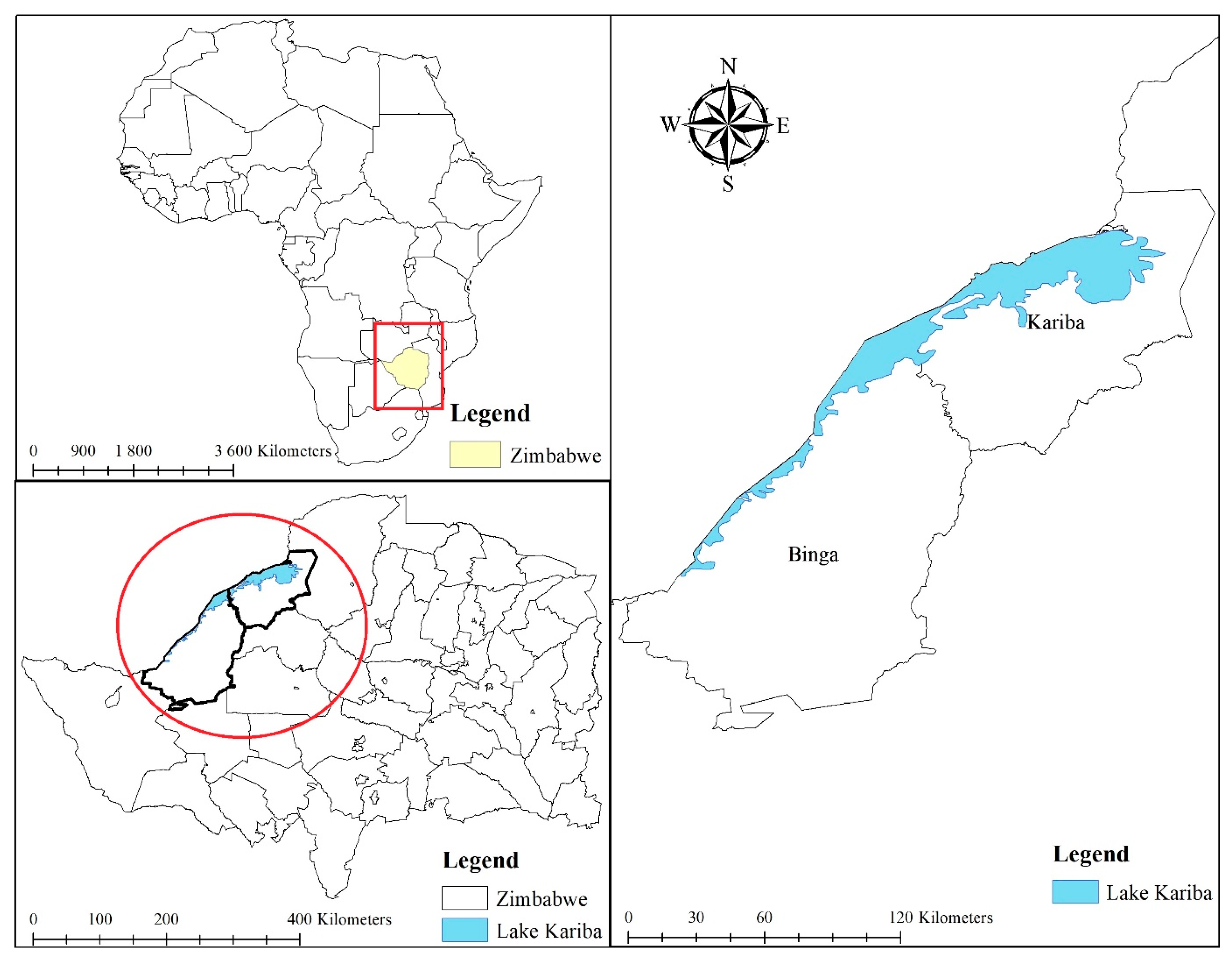
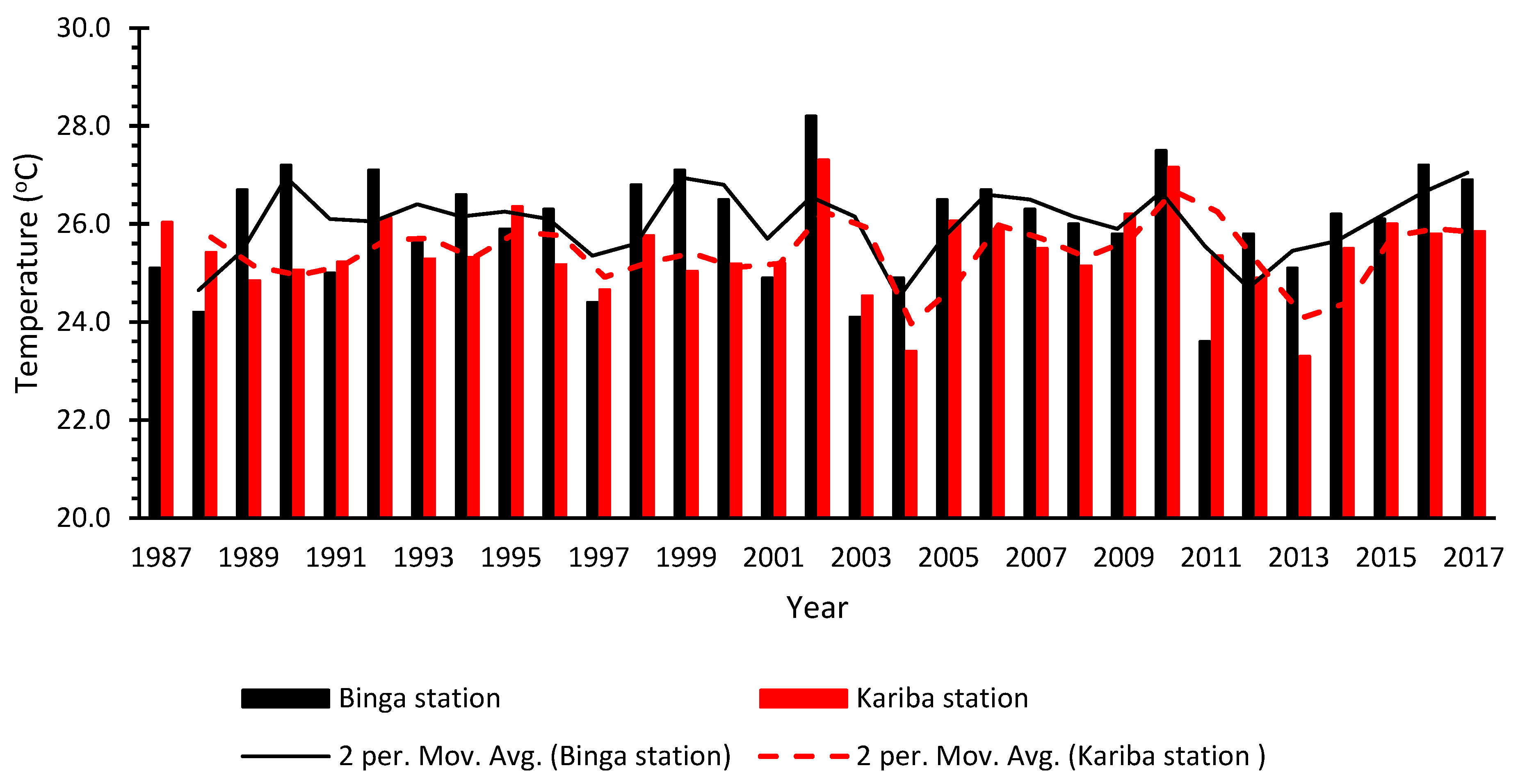
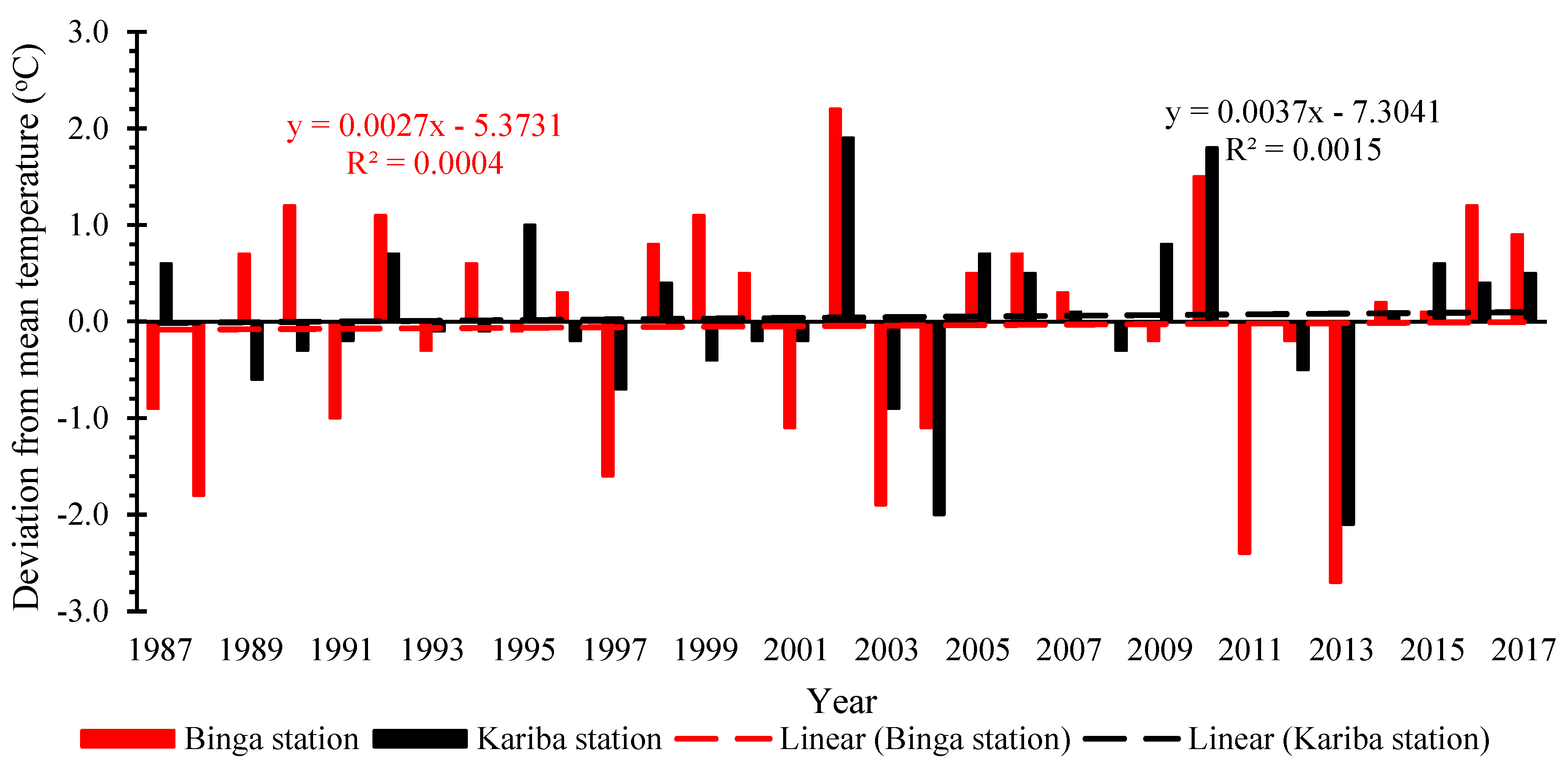

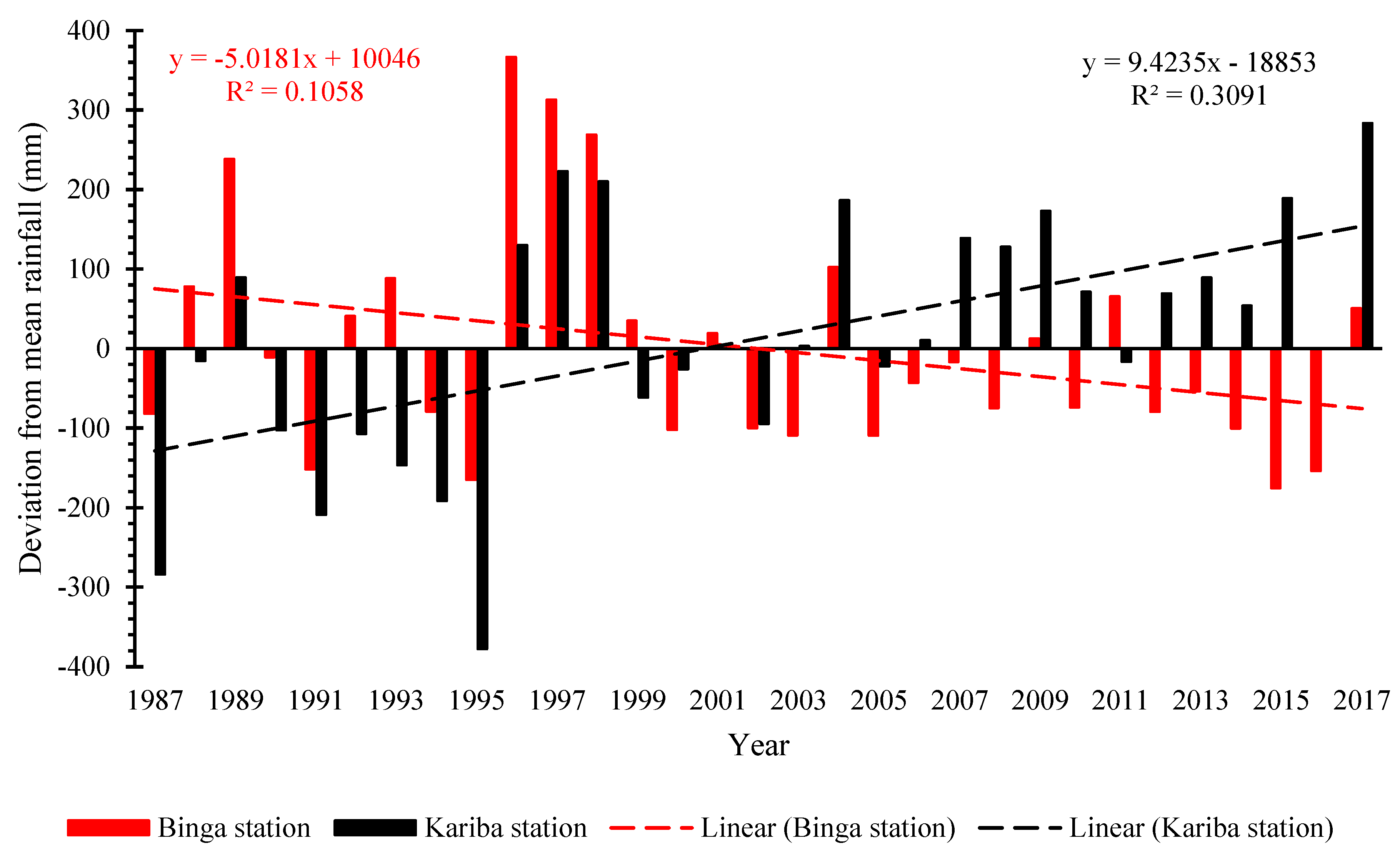
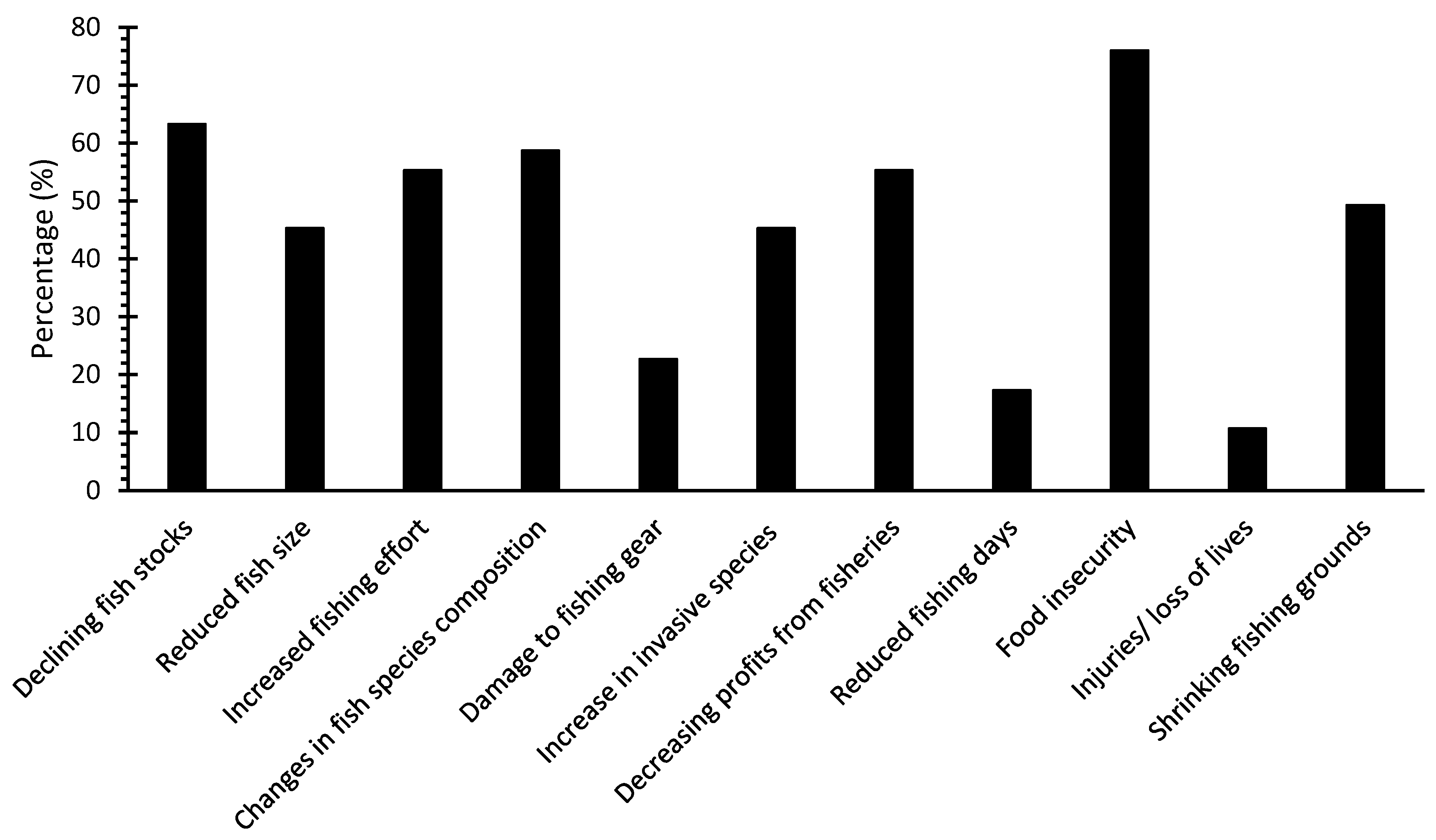
| Household Characteristic | Study Areas | Total (n = 120) | Percentage (%) | ||
|---|---|---|---|---|---|
| Binga (n = 55) | Kariba (n = 65) | ||||
| Age | <20 | 1 | 3 | 4 | 3.3 |
| 21–30 | 4 | 6 | 10 | 8.3 | |
| 31–40 | 11 | 24 | 35 | 29.2 | |
| 41–50 | 13 | 26 | 39 | 32.5 | |
| 51–60 | 19 | 4 | 23 | 19.2 | |
| >60 | 7 | 2 | 9 | 7.5 | |
| Gender | Male | 43 | 49 | 92 | 76.7 |
| Female | 12 | 16 | 28 | 23.3 | |
| Marital Status | Never Married | 4 | 11 | 15 | 12.5 |
| Married | 43 | 51 | 94 | 78.3 | |
| Divorced | 1 | - | 1 | 0.8 | |
| Widowed | 7 | 3 | 10 | 8.3 | |
| Education Level | Never attended | 5 | 9 | 14 | 11.7 |
| Primary school | 12 | 14 | 26 | 21.7 | |
| Secondary school | 38 | 41 | 79 | 65.8 | |
| Tertiary | - | 1 | 1 | 0.8 | |
| Household Size | 1–3 | 5 | 9 | 14 | 11.7 |
| 4–6 | 31 | 44 | 75 | 62.5 | |
| 7–9 | 16 | 11 | 27 | 22.5 | |
| >9 | 3 | 1 | 4 | 3.3 | |
| Period of Stay in the Area | <5 | - | 1 | 1 | 0.8 |
| 6–10 | 3 | 7 | 10 | 8.3 | |
| 11–15 | 10 | 11 | 21 | 17.5 | |
| 16–20 | 8 | 16 | 24 | 20 | |
| 21–25 | 6 | 9 | 15 | 12.5 | |
| 26–30 | 5 | 11 | 16 | 13.3 | |
| 31–35 | 10 | 8 | 18 | 15 | |
| >35 | 13 | 2 | 15 | 12.5 | |
| Household dependents | 0 | 6 | 13 | 19 | 15.8 |
| 1–3 | 10 | 11 | 21 | 17.5 | |
| 4–6 | 13 | 7 | 20 | 16.7 | |
| >6 | 26 | 34 | 60 | 50 | |
| Explanatory Variables | Coding | Category |
|---|---|---|
| Age | Years | Continuous |
| Gender | 0 = male, 1 = female | Dummy |
| Marital status | 0 = married; 1 = otherwise | Dummy |
| Education level | 0 = formal education; 1 = no formal education | Dummy |
| Fishing experience | Years | Continuous |
| Perception of Climate Change | 0 = knowledgeable; 1 no knowledge | Dummy |
| Climate Parameters | Participant’s Response | |||
|---|---|---|---|---|
| Increase (%) | Decrease (%) | No Change (%) | Do Not Know (%) | |
| Temperature | 83.8 | 11.9 | 4.3 | - |
| Rainfall | 5.6 | 76.3 | 6.3 | 11.8 |
| Frequency of floods | 56.9 | 12.5 | 21.9 | 8.7 |
| Frequency of droughts | 63.1 | 18.1 | 3.8 | 15 |
| Surface water levels | 25 | 37.5 | 30.6 | 6.9 |
| Strategies | Frequency (n = 120) | Percentage (%) |
|---|---|---|
| Change fishing gear | 51 | 42.5 |
| Targeting new fish species | 24 | 20 |
| Increasing fishing time/days | 53 | 44.2 |
| Diversifying livelihoods | 17 | 14.2 |
| Increased fishing effort | 54 | 45 |
| Migrating to a new fishing community | 9 | 7.5 |
| Variable | Change Fishing Gear | Targeting New Fish Species | Increasing Fishing Time/Days | Diversifying Livelihoods | Increased Fishing Effort | Migrating to a New Fishing Community | ||||||
|---|---|---|---|---|---|---|---|---|---|---|---|---|
| Coeff. | Sig. (p-Value) | Coeff. | Sig. (p-Value) | Coeff. | Sig. (p-Value) | Coeff. | Sig. (p-Value) | Coeff. | Sig. (p-Value) | Coeff. | Sig. (p-Value) | |
| Age | −1.687 | 0.215 | −1.632 | 0.207 | 1.577 | 0.304 | 4.203 | 0.035 * | 0.771 | 0.052 | 0.020 | 0.892 |
| Gender | −0.002 | 0.996 | 0.232 | 0.564 | 0.603 | 0.139 | 0.128 | 0.257 | 0.888 | 0.030 * | −0.055 | 0.257 |
| Marital status | 0.129 | 0.638 | 0.037 | 0.895 | 0.049 | 0.224 | 0.290 | 0.063 | −0.014 | 0.771 | −1.607 | 0.230 |
| Education level | 1.708 | 0.048 * | 0.218 | 0.721 | 0.153 | 0.812 | 2.249 | 0.009 * | 1.747 | 0.068 | 0.0153 | 0.670 |
| Experience | 0.314 | 0.006 * | 0.323 | 0.004 * | 0.384 | 0.001 * | 1.257 | 0.066 | 0.331 | 0.004 * | −3.345 | 0.072 ** |
| Perception on CC | 0.029 | 0.415 | 1.755 | 0.040 * | 0.183 | 0.877 | 2.300 | 0.007 * | 2.211 | 0.010 * | −0.004 | 0.927 |
| Base category Total number of observations Likelihood ratio Chi2 Log Likelihood | No Adaptation 120 141.564 −123.567 | |||||||||||
Publisher’s Note: MDPI stays neutral with regard to jurisdictional claims in published maps and institutional affiliations. |
© 2022 by the authors. Licensee MDPI, Basel, Switzerland. This article is an open access article distributed under the terms and conditions of the Creative Commons Attribution (CC BY) license (https://creativecommons.org/licenses/by/4.0/).
Share and Cite
Muringai, R.T.; Mafongoya, P.; Lottering, R.T. Climate Change Perceptions, Impacts and Adaptation Strategies: Insights of Fishers in Zambezi River Basin, Zimbabwe. Sustainability 2022, 14, 3456. https://doi.org/10.3390/su14063456
Muringai RT, Mafongoya P, Lottering RT. Climate Change Perceptions, Impacts and Adaptation Strategies: Insights of Fishers in Zambezi River Basin, Zimbabwe. Sustainability. 2022; 14(6):3456. https://doi.org/10.3390/su14063456
Chicago/Turabian StyleMuringai, Rodney Tatenda, Paramu Mafongoya, and Romano Trent Lottering. 2022. "Climate Change Perceptions, Impacts and Adaptation Strategies: Insights of Fishers in Zambezi River Basin, Zimbabwe" Sustainability 14, no. 6: 3456. https://doi.org/10.3390/su14063456
APA StyleMuringai, R. T., Mafongoya, P., & Lottering, R. T. (2022). Climate Change Perceptions, Impacts and Adaptation Strategies: Insights of Fishers in Zambezi River Basin, Zimbabwe. Sustainability, 14(6), 3456. https://doi.org/10.3390/su14063456








